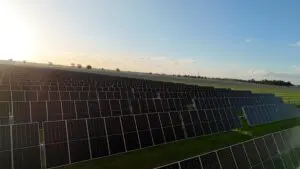The winds of change in the energy industry has struck at the heart of the earnings of another of the country’s big three utilities, EnergyAustralia, which has reported a 42 per cent slump in profits as a result of the changing dynamics in the sector – lower wholesale prices, greater uptake of solar, and other decentralised generation, and lower consumption from energy efficiency.
It may seem ironic that in a year when consumer electricity prices jumped so sharply that Australia’s biggest energy utilities should suffer such sharp falls in profit. But the other big trend to weigh on EnergyAustralia’s earnings was a cost-conscious public, who are either reducing consumption or producing it themselves, through rooftop solar.
EnergyAustralia said that on average, its average electricity sales per household in Victoria fell by more than 10 per cent from 6.5MWhs in 2011 to 5.8MWhs in 2012. Across the eastern seaboard, the fall in consumption from its more than 2.5 million retail customers fell by between 5 and 10 per cent.
So fine have energy business models been calibrated that this fall in demand translated into a fall in the retail electricity business of around 25 per cent, and a fall in the profits of the overall business by 42 per cent to HK$1,685 million, compared to HK$2,911 million the previous year. (EnergyAustralia is owned by the Hong Kong based CLP Holdings). This fall follows a 35 per cent fall in earnings from the country’s largest energy retailer, Origin Energy, announced last week.
The brown coal Yallourn power station was hit by flooding in its mine caused by the collapse of a coal conveyor, and additional losses, but EnergyAustralia said that the combined effect of falling demand and a suppressed wholesale price caused it to close one of its four generation units until the summer heat brought increased demand in early January. One of the few strong parts of its wholesale operations was its renewables business – which lifted profits from $91 million to $158 million.
The deterioration in earnings forced CLP to cancel its planned stock market listing of EnergyAustralia last year, and it now seems that the float has been put on hold indefinitely – or at least until the company can recalibrate its business model. Perhaps the same issues need to be confronted by the state-owned generators and network operators in NSW and Queensland.
EnergyAustralia says one key focus of the coming year will be the managing the implications of reducing growth in energy demand, which it noted is leading to suppressed wholesale prices.
“This requires EnergyAustralia to pursue strategies which optimise the manner in which the availability of its generating capacity and energy trading activities are conducted,” it said, suggesting that Yallourn units may be pulled offline – at least in the winter months – in the future.
Its other key focus, it says, will be on “policy advocacy”. EnergyAustralia was one of the fiercest opponents of the Renewable Energy Target, arguing that maintaining the fixed target of 41,000GWh would cause damage to its business, and raise costs for customers. It noted in this week’s announcement that the wholesale price continued to be lowered by the build-out of renewables.
That argument against the RET was rejected by the Climate Change Authority, which recommended the status quo be retained. But EnergyAustralia seems hopeful that its argument may win out in the end.
In its outlook, CLP says it foresees it building only a “limited amount of wind generating capacity” – possibly in the hope that an Abbott government would dilute the RET.
The Coalition has had an ambiguous stance on the RET, but the signs grow that a backdown is likely, or even probable. The Australian Financial Review, in a front page splash, today notes that one of the Liberal Party’s star recruits, Angus Taylor, from the consulting firm Port Jackson partners, has issued a detailed report recommending that the RET be diluted because of the “high cost” of abatement from wind farms, and even suggests that gas-fired generation by included in the RET.
(Another of the Coalition’s other star recruits, Zed Seselja from the ACT, has also spoken out against wind and solar, and both the national and ACT renewable energy targets. All the coalition state premiers oppose the RET as well).
Ian MacFarlane, the opposition energy spokesman who as minister brought the first renewable energy target to a sudden and dramatic end more than a decade ago, was quoted as saying that the Coalition would wait until the next RET review in 2014.
The CCA has recommended that the next RET review not take place until 2016. However, its recommendations have yet to be endorsed by the Labor government, and it’s not entirely clear that the four year time period for the RET review will be implemented. In any case, the Coalition intends to scrap the CCA as one of its first acts of government.
Interestingly, one of Taylor’s suggestions is that Australian generators be allowed to buy credits from offshore generators to satisfy their RET obligations. “A tonne of carbon from New Guinea is the same from a policy point of view. Frankly, it doesn’t matter – what matters is whether you are going to get the abatement,” he was quoted as saying by the AFR. Presumably, he’s quite enamoured by Origin Energy’s proposed 2,200MW hydro project in PNG.
Port Jackson Partners, it should be noted, produced the research for a BCA subsmission on carbon pricing, which I wrote at the time was one of the most appalling presentations that the BCA had ever produced.
Additional note: One interesting observation from the CLP results was its confirmation that it planned to invest in no new coal-fired capacity in India, one of the fastest growing energy markets in the world. CLP has long complained about infrastructure issues, which has restricted deliveries to its coal-fired plants, including the newly built Jhajjar Power Station, which has been running at just 33 per cent capacity, instead of its planned 86 per cent, incurring significant losses.
This is an issue we highlighted in our story Is India the fossil fuel nirvana imagined by Rinehart and Co last year. CLP says it will instead focus on renewable energy projects in India in the future, and according to Deutsche Bank, that is what large industrial users in India will do as well.







